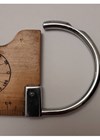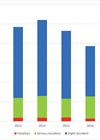Optometry
The Preston Rule
The selection, specification and fitting of a spectacle frame necessitates the recording of certain measurements particular to the frame. These measurements are also essential when it is required to manufacture a handmade spectacle frame. Instruments designed to accomplish this task...
Providing primary eyecare services during a global pandemic: the new normal
It would be fair to say that 2020 hasn’t quite turned out to be the year that anyone predicted. Living with a global pandemic has become our reality and we are having to get used to many aspects of our...
Developing community eye care: the evolution of Wales’ eye care services
In the third in our series about community eye care in the home nations, David O’Sullivan explains how Wales has developed its community eye care services. Since the devolution of healthcare to Wales on 1 July 1999 [1], significant changes...
How to be a better optometrist – a personal view
Our optometry editor shares her personal observations of what makes the best optometrist. Some years ago in Glasgow, I gave a presentation with this same title, ‘How to be a better optometrist’. I was the optometry programme director for NHS...
“I can see fine. Why do I need my eyes tested?”
Are routine eye examinations really necessary? The author asks whether frequent appointments in low-risk patients with normal results are actually cost-effective. It’s recommended that most people should get their eyes tested every two years.” [1] This message is widely publicised...
Illuminating task lighting
Good lighting is always important but especially for patients who are visually impaired. Janet Pooley provides an overview. We tend to discuss lighting with patients when their vision is reduced, and where we are considering higher reading adds or low...
Improving eye care for children with learning difficulties: a view from SeeAbility
Marek P Karas from sightloss charity SeeAbility examines why children with a learning disability do not access the eye care they need and asks how the system needs to change. Children with a learning disability are 28 times more likely...
Eyes on the road – visual standards for car drivers
The author examines the current visual standards required by drivers and asks whether more needs to be done to make roads safer. Are the public adequately protected by the current system of visual standards required by drivers? In a survey...
Meeting the needs of older patients in optics
Fiona Anderson discusses the important role of community-based eyecare practitioners in meeting the visual needs of ageing patients. It has been well documented that today we live for longer. Statistics show in 1997, around one in every six people (15.9%)...
Developing community eye care: the GOS package in Scotland
In the second in the series about community eye care in the home nations, Janet Pooley explains how Scotland has developed its services within GOS. The United Kingdom has devolved healthcare; the powers were transferred from Westminster to Scotland and...
Flashes and floaters in community optometry – diagnosing a posterior vitreous detachment
Managing patients who attend a practice with symptoms of flashes and floaters is a regular occurrence in community optometric practice. It’s often very distressing for patients; symptoms can be quite dramatic and an internet search can indicate imminent blindness from...
Patient safety – is this achieved in optometry with CET?
Collecting points and ticking boxes – as we come to the end of another three year cycle of continuing education and training (CET), the rush to ensure that everything has been completed on the myGOC (General Optical Council) dashboard feels...












